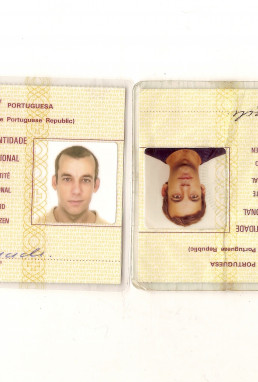“O DUPLO”
mala voadora
As personagens que tiveram origem no teatro não são as mais presentes no imaginário coletivo.
Fora de um campo de relativa erudição, o Batman é uma referência mais presente do que Hamlet; e a Barbie mais do que a Mãe Coragem. “Contar histórias” não é o mesmo depois da instauração de uma cultura pop. É na consideração deste contexto cultural que, em O Duplo, a mala voadora coloca a possibilidade da construção de uma personagem, recorrendo para isso a vários dos artificialismos de um espetáculo de teatro (em particular o vídeo).
O Duplo parte do confronto com a História das personagens criadas ou adotadas pela “cultura de massas” ocidental. Parte, mais concretamente, do confronto com algumas das mais populares personagens dessa História: aquelas que se tornaram efetivas referências culturais; aquelas que retêm o paradigma da híper-individualidade; aquelas com as quais também a possibilidade de uma narrativa não pode deixar de confrontar-se.
Este espetáculo integra-se num ciclo que a mala voadora tem vindo a desenvolver em torno das prerrogativas e limitações – sociais e artísticas – da identidade. (1) Em O decisivo na política não é o pensamento individual, mas sim a arte de pensar a cabeça dos outros. (disse Brecht), promove-se uma “decantação” da retórica das tomadas de posição ideológicas através da justaposição de discursos políticos díspares. (2) Chinoiserie baseia-se em fenómenos de construção de identidade cultural. (3) Huis Clos, de Jean-Paul Sartre, evidencia que a identidade de cada indivíduo reside no reflexo que dela é devolvido pelos outros. (4) Agora, em O Duplo, evoca-se a identidade ficcional da “personagem”.
Ficha técnica
Direção Jorge Andrade
Com Ana Brandão, Bruno Huca e Jorge Andrade
Cenografia José Capela
Vídeo UZI filmes
Banda Sonora Rui Lima, Sérgio Martins
A mala voadora é uma estrutura financiada pelo Ministério da Cultura / Direção Geral das Artes.
A mala voadora é uma estrutura associada da Associação Zé dos Bois (ZDB).
“O DUPLO”
mala voadora
The characters that were originated in the theater are not the most present in the collective imaginary.
Out of a relative erudition field, Batman is a more present reference than Hamlet; and Barbie more than Mother Courage. “Telling stories” is not the same after the establishment of a pop culture. Concerning this cultural context and this show, mala voadora creates the possibility of building a character using several artificialities of a theater show (the video, in particular).
O Duplo begins with the confrontation with the characters’ history created or adopted by the western mass culture. More specifically, it begins with the confrontation with some of the most popular characters of that History: those that have become effective cultural references; those that retain the hyper-individuality paradigm; those which the possibility of a narrative has to be confronted with.
This show is part of a cycle in which mala voadora has been developing around the prerogatives and limitations of identity, the social and artistic ones. (1) In The decisive in politics is not the individual thought, but the art of thinking what’s in the others’ mind. (Brecht said), a “decantation” of the ideological positions’ rhetoric is promoted through the juxtaposition of disparate political discourses. (2) Chinoiserie is based on cultural identity-building phenomena. (3) Jean-Paul Sartre’s Huis Clos highlights that the identity of each individual resides in the reflection that is given back by others. (4) Now, in O Duplo, one evokes the fictional identity of the “character.”
Credits
Direction Jorge Andrade
With Ana Brandão, Bruno Huca and Jorge Andrade
Scenography José Capela
Video UZI filmes
Soundtrack Rui Lima and Sérgio Martins
mala voadora is a structure financed by the Ministry of Culture (Portugal)/Direção Geral das Artes.
mala voadora is a structure linked to Associação Zé dos Bois (ZDB).
